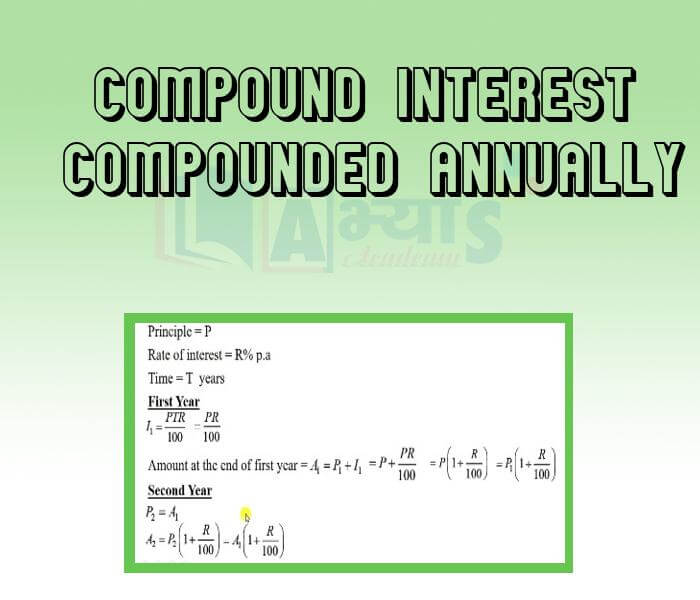Compound Interest Compounded Annually






Compound Interest Compounded Annually
Definition: Compound interest is calculated as a percentage as a total amount a the end of the previous compounding period.
Formula:
First Type:  ,
,
where  = Future Value
= Future Value
= Present Value or Original Amount
= Annual Interest Rate as a Decimal
= multiplier
n = number of years of investment
Illustration: What will Rs 5000 invested at 8% p.a compound interest amount to after 2 years ?
Solution : An interest rate of 8% indicates that i = 0.08.
For 2 years , n = 2 and so = Rs 5000
= Rs 5832
Second Type:
To find interest only, we use
Compound interest = -
Illustration: How much interest is earned according to the above example1 .
Solution : interest earned = $ 5832 - $ 5000 = $ 832
now , To Find Compound Interest (CI) when Interest is Compounded Annually:
In such cases where interest is compounded yearly, the interest accrued during the first year is added to the principal and the amount so obtained becomes the principal for the second year. The amount at the end of the second year becomes the principal for the third year, and so on.
Illustration: Find the compound interest on Rs 25000 for 3 years at 6% per annum, compounded annually.
Solution: Principal for the first year = Rs. 25000.
Amount at the end of the first year = 25000 + 1500 = Rs 26500.
Principal for the second year = Rs. 26500.
Amount at the end of the second year = Rs 26500 + 1590 = Rs 28090.
Principal for the third year = Rs 28090.
Amount at the end of the third year = 28090 + 1685.40 = Rs 29775.40.
Therefore, compound interest = 29775.40 - 25000 = Rs 4775.40.
Compound Interest By Formula:
For the above example:
Principal = 25000
Rate= 6%
time= 3 years
Therefore, compound interest = 29775.40 - 25000 = Rs 4775.40.
Find the compound interest on Rs. 12000 for 3 years at 10% p.a. compounded annually. | |||
| Right Option : A | |||
| View Explanation | |||
A man borrowed Rs. 3125 for CI and it amounted to Rs. 4500 in 2 years. The rate of CI per annum is : | |||
| Right Option : C | |||
| View Explanation | |||
Rahul took Rs 1,000 loan for 12 months and it says "5% per annum", how much did Rahul pay back if the interest is compounded annually? | |||
| Right Option : A | |||
| View Explanation | |||
Students / Parents Reviews [10]
I have spent a wonderful time in Abhyas academy. It has made my reasoning more apt, English more stronger and Maths an interesting subject for me. It has given me a habbit of self studying

Yatharthi Sharma
10thAbout Abhyas metholodology the teachers are very nice and hardworking toward students.The Centre Head Mrs Anu Sethi is also a brilliant teacher.Abhyas has taught me how to overcome problems and has always taken my doubts and suppoeted me.

Shreya Shrivastava
8thAbhyas Methodology is very good. It is based on according to student and each child manages accordingly to its properly. Methodology has improved the abilities of students to shine them in future.

Manish Kumar
10thAbhyas is a complete education Institute. Here extreme care is taken by teacher with the help of regular exam. Extra classes also conducted by the institute, if the student is weak.

Om Umang
10thOne of the best institutes to develope a child interest in studies.Provides SST and English knowledge also unlike other institutes. Teachers are co operative and friendly online tests andPPT develope practical knowledge also.

Aman Kumar Shrivastava
10thBeing a parent, I saw my daughter improvement in her studies by seeing a good result in all day to day compititive exam TMO, NSO, IEO etc and as well as studies. I have got a fruitful result from my daughter.

Prisha Gupta
8thIt was a good experience with Abhyas Academy. I even faced problems in starting but slowly and steadily overcomed. Especially reasoning classes helped me a lot.

Cheshta
10thMy experience with Abhyas is very good. I have learnt many things here like vedic maths and reasoning also. Teachers here first take our doubts and then there are assignments to verify our weak points.

Shivam Rana
7thMy experience was very good with Abhyas academy. I am studying here from 6th class and I am satisfied by its results in my life. I improved a lot here ahead of school syllabus.

Ayan Ghosh
8thIt has a great methodology. Students here can get analysis to their test quickly.We can learn easily through PPTs and the testing methods are good. We know that where we have to practice
